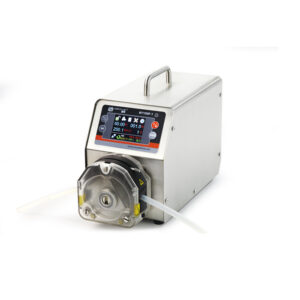In the field of laboratory analysis, accurate and precise dispensing of diagnostic reagents is crucial for obtaining reliable test results. One of the key tools used for this purpose is the diagnostic reagent dispensing peristaltic pump. This specialized pump offers a controlled and consistent flow of reagents, ensuring precise volumes are delivered for various diagnostic applications. In this article, we will delve into the features, functioning, and applications of the diagnostic reagent dispensing peristaltic pump, highlighting its significance in laboratory analysis.
Understanding the Diagnostic Reagent Dispensing Peristaltic Pump
- Function:The diagnostic reagent dispensing peristaltic pump is designed specifically for accurately and consistently delivering diagnostic reagents in laboratory settings. It operates on the principle of peristalsis, using a rotating roller system to compress and release a flexible tubing, creating a positive displacement action that propels the reagent through the tubing and into the desired container.
- Features:Diagnostic reagent dispensing peristaltic pumps are equipped with features that make them ideal for laboratory applications, including:
- High-quality tubing materials that are compatible with a wide range of reagents, ensuring chemical resistance and preventing contamination.
- Adjustable Flow Rates: The ability to adjust the pump’s rotational speed or tubing compression to achieve precise and customizable flow rates, allowing for accurate dispensing of reagents.
- Dispensing Accuracy: These pumps offer excellent dispensing accuracy, typically within a few microliters, ensuring reproducible results and minimizing wastage.
- Easy Maintenance: Peristaltic pumps are relatively easy to clean and maintain, as the reagent only contacts the tubing, which can be easily replaced after each use.
Applications of Diagnostic Reagent Dispensing Peristaltic Pump
- Clinical Diagnostics:
In clinical laboratories, diagnostic reagent dispensing peristaltic pumps are used for precise delivery of reagents in various diagnostic tests, such as immunoassays, clinical chemistry, and molecular biology. These pumps ensure accurate volumes of reagents are dispensed, contributing to reliable and reproducible test results. - Pharmaceutical Analysis:
Pharmaceutical laboratories utilize diagnostic reagent dispensing peristaltic pumps for the preparation and dispensing of critical reagents in drug formulation, quality control analysis, and stability testing. The pumps enable precise and controlled delivery, ensuring accurate dosing and maintaining the integrity of the pharmaceutical samples. - Environmental Testing:
Diagnostic reagent dispensing peristaltic pumps find application in environmental testing laboratories for the accurate dispensing of reagents used in water quality analysis, soil testing, and air pollution monitoring. These pumps play a vital role in ensuring precise volumes of reagents are added to samples, facilitating accurate measurements and analysis. - Food and Beverage Analysis:
Quality control laboratories in the food and beverage industry utilize diagnostic reagent dispensing peristaltic pumps to dispense reagents for various tests, such as pH measurement, titration, and microbial analysis. These pumps contribute to the accuracy and reliability of food and beverage analysis, ensuring compliance with safety and quality standards. - Research and Development:
Diagnostic reagent dispensing peristaltic pumps are employed in research and development laboratories across scientific disciplines. They are used for precise dispensing of reagents in experiments, assays, and process development, enabling researchers to achieve consistent and controlled conditions for their investigations.
Advantages of Diagnostic Reagent Dispensing Peristaltic Pump
- Precision and Accuracy:
These pumps offer exceptional dispensing precision and accuracy, ensuring consistent volumes of reagents are delivered. This attribute is critical for obtaining reliable and reproducible laboratory results. - Contamination Prevention:
Diagnostic reagent dispensing peristaltic pumps employ a closed tubing system, which prevents contamination of the reagent and cross-contamination between different samples or solutions. This feature enhances the integrity and reliability of analytical results. - Easy Operation and Maintenance:
Peristaltic pumps are generally user-friendly, with intuitive controls and straightforward maintenance requirements. The tubing can be easily replaced, minimizing downtime and reducing the risk of carryover between samples. - Versatility:
Diagnostic reagent dispensing peristaltic pumps can accommodate a wide range of reagents and volumes, making them versatile tools in laboratory analysis. They can handle both aqueous and non-aqueous solutions, as well as viscous and volatile reagents.
The diagnostic reagent dispensing peristaltic pump is an indispensable tool in laboratory analysis, providing precise and accurate dispensing of diagnostic reagents across various applications. Its ability to deliver controlled volumes with high accuracy contributes to reliable test results, diagnostic reagent dispensing peristaltic pump enhancing the quality and integrity of laboratory analysis. Whether in clinical diagnostics, pharmaceutical analysis, environmental testing, or research and development, the diagnostic reagent dispensing peristaltic pump plays a vital role in ensuring the success andreproducibility of laboratory experiments and analyses. With its user-friendly operation, contamination prevention, and versatility, this pump continues to be a key component in the advancement of scientific research and the improvement of healthcare diagnostics.
